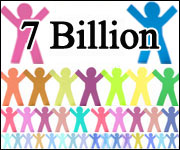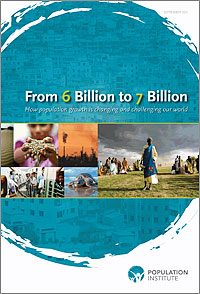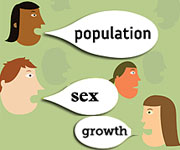 The subject of population — like sex, politics, and religion — elicits such strong opinions that people often go out of their way to avoid talking about it. That’s led many to believe that population growth is no longer a valid concern, but if you’re worried about people, posterity, or the planet, it’s time to talk.
The subject of population — like sex, politics, and religion — elicits such strong opinions that people often go out of their way to avoid talking about it. That’s led many to believe that population growth is no longer a valid concern, but if you’re worried about people, posterity, or the planet, it’s time to talk.
On Oct. 31, world population will cross the 7 billion mark. There’s nothing particularly significant about that number. It’s just a milestone, but it’s also an opportunity for reflection and recalibration.
A lot has happened since world population crossed the 6 billion mark in 1999. The world today is a much different place, and it has changed in ways that profoundly affect the human prospect. Soaring prices for energy and essential foodstuffs, along with climate change and water scarcity, are raising legitimate questions about the Earth’s ability to provide for an ever-expanding human population. The gains that we have made in reducing severe poverty, eliminating hunger, and improving health outcomes in the developing world may not be sustainable, unless more is done to empower women, educate girls, and expand the availability of contraceptives.
Twelve years ago, when world population reached 6 billion, the human prospect looked immeasurably brighter than it does today. Prices for energy and food were at or near historic lows. As a consequence, hunger and severe poverty were on the run. The world was already warming, but hopes were high that the nations of the world would soon act to reduce the level of greenhouse gas emissions and avert the worst effects of climate change. The global economy was booming, and it appeared that the U.S. and other donor nations would provide the foreign assistance that would be needed to accelerate human and economic development. And, while there was growing concern about humanity’s impact on the global environment, many believed that world population would start to decline by mid-century and that, long before then, advances in the use of renewable energy and green technologies would reduce humanity’s ecological footprint.
 Read more on population. Check out our series 7 billion: What to expect when you’re expanding.But over the past 12 years, the trends have not gone according to script. Oil prices shot from a low of $13 a barrel in 1999 to $113 a barrel earlier this year, and they’re now hovering around $86. The prices of grains and other essential foodstuffs have more than doubled. Hunger and severe poverty have made a comeback. The fight against climate change has been nearly abandoned. The global economy has been battered. Economic development assistance has fallen short of expectations. Water scarcity and resource limitations have grown more acute. And the transition to a green economy has not been as swift as many hoped. In the meantime, world population keeps on growing with no end in sight. If fertility rates don’t continue to fall, population could soar as high as 15 billion by the end of this century.
Read more on population. Check out our series 7 billion: What to expect when you’re expanding.But over the past 12 years, the trends have not gone according to script. Oil prices shot from a low of $13 a barrel in 1999 to $113 a barrel earlier this year, and they’re now hovering around $86. The prices of grains and other essential foodstuffs have more than doubled. Hunger and severe poverty have made a comeback. The fight against climate change has been nearly abandoned. The global economy has been battered. Economic development assistance has fallen short of expectations. Water scarcity and resource limitations have grown more acute. And the transition to a green economy has not been as swift as many hoped. In the meantime, world population keeps on growing with no end in sight. If fertility rates don’t continue to fall, population could soar as high as 15 billion by the end of this century.
There always have been compelling reasons for making family-planning services and reproductive-health services more widely available to women in the developing world. Access to contraceptives lowers maternal and infant mortality. It increases the chances that girls and boys will stay in school longer. It allows women to enter the workforce, and enables families to save and prosper. It improves reproductive health, and lowers the chances that family members will acquire HIV/AIDS. Similarly, there always have been strong arguments for investing more in girls, keeping them in school longer, and delaying the age of marriage. Female empowerment and gender equality have been, and remain, moral and social imperatives.
But, despite all the manifest benefits and the moral imperatives, the world has moved too slowly to fulfill the pledges made at the International Conference on Population and Development that was held in Cairo in 1994. And while the U.N.’s Millennium Development Goal 5(b) sets 2015 as the target year for achieving universal access to family planning and other reproductive-health services, that target is far from being met.
 Logically, you might think the events of the past decade would have spurred a significant increase in global support for family planning and reproductive-health programs, but so far they have not. In the United States, Texas, New Jersey, and other states have slashed their support for family-planning clinics, and Congress is on the verge of cutting federal support for both domestic and international family planning. In the developing world, where fertility rates are highest, donor nation support for reproductive-health programs has fallen dramatically. It’s no wonder that birthrates are not falling as fast as previously projected, and that maternal and infant mortality has remained unacceptably high in the developing world.
Logically, you might think the events of the past decade would have spurred a significant increase in global support for family planning and reproductive-health programs, but so far they have not. In the United States, Texas, New Jersey, and other states have slashed their support for family-planning clinics, and Congress is on the verge of cutting federal support for both domestic and international family planning. In the developing world, where fertility rates are highest, donor nation support for reproductive-health programs has fallen dramatically. It’s no wonder that birthrates are not falling as fast as previously projected, and that maternal and infant mortality has remained unacceptably high in the developing world.
The Population Institute has just released a report, “From 6 Billion to 7 Billion: How Population Growth Is Changing and Challenging Our World” [PDF], that examines the state of world population. It’s our hope that this report and the observance of the 7 billion population mark will generate a renewed commitment to family planning and the empowerment of women and girls. There’s a lot at stake. That’s why we are joining with other organizations in declaring that “It’s time to talk.”
The largest-ever generation of young people is now entering prime reproductive years. We owe it to them, and their posterity, to provide them with the reproductive health and rights that are rightfully theirs. The cost of doing so is minimal. Providing family-planning services to the 215 million women in developing countries who want to avoid a pregnancy, but who are not using a modern method of birth control, would cost less than $4 billion a year. Similarly, small investments in the education of girls in the developing world effectively delay marriage, lower fertility rates, and dramatically improve health and well-being.
Reducing projected population growth is a critical challenge, but it’s not an insurmountable one. It’s time to talk.



